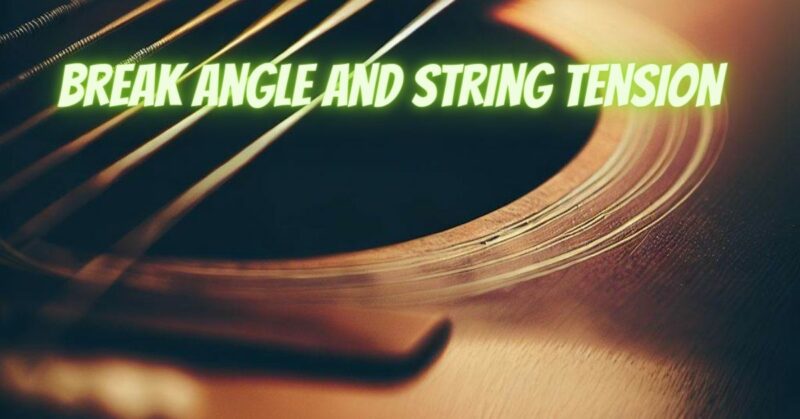The relationship between break angle and string tension is a critical yet often overlooked aspect of guitar setup. Both factors play a significant role in shaping the instrument’s playability, tone, and overall performance. In this article, we will delve into the intricate connection between break angle and string tension, exploring how they influence each other and impact your guitar’s characteristics.
Understanding Break Angle and String Tension
Before we explore their interplay, let’s define break angle and string tension:
- Break Angle: Break angle refers to the angle at which the strings pass over the nut and bridge of a guitar. This angle can vary depending on the design of the instrument and its setup.
- String Tension: String tension is the force applied by the tightened strings on the guitar neck and body. It is influenced by factors such as string gauge, tuning, and scale length.
The Interplay Between Break Angle and String Tension
The relationship between break angle and string tension is complex and multifaceted:
- String Tension Affects Break Angle: The tension in the strings directly influences the break angle. Higher string tension typically results in a steeper break angle, especially at the nut. Conversely, lower tension leads to a shallower break angle.
- Impact on Playability: The break angle affects how the strings feel and respond when you play. A steeper break angle can provide a firmer, more controlled feel, which some players prefer. In contrast, a shallower break angle can make the strings feel slinkier and easier to bend.
- Tonal Considerations: The break angle influences the transfer of string vibrations to the guitar’s body and neck. A steeper angle can result in greater string-to-surface contact at the nut and saddle, potentially enhancing sustain and note clarity. However, a shallower angle may provide a brighter, snappier tone.
- String Bending: The ease of string bending is affected by both break angle and string tension. A shallower break angle combined with lower tension can make bending strings more effortless, allowing for expressive playing techniques.
- Guitar Setup and Preferences: The choice of break angle and string tension can be influenced by your guitar’s setup and your personal playing style and preferences. Different players may gravitate toward specific setups to achieve their desired feel and tone.
Factors Influencing Break Angle and String Tension
Several factors can influence both break angle and string tension on your guitar:
- String Gauge: Heavier gauge strings exert more tension and can result in a steeper break angle. Lighter gauge strings have lower tension and may lead to a shallower break angle.
- Scale Length: The scale length of your guitar impacts string tension. Longer scales generally require higher tension strings to maintain pitch, which can affect the break angle.
- Tuning: Different tunings can alter string tension. Lower tunings may reduce tension, affecting the break angle, while higher tunings can increase it.
- Nut and Saddle Material: The materials used for the nut and saddle can influence the break angle. Materials like bone or synthetic alternatives can affect string-to-surface contact.
- Guitar Setup: A well-adjusted guitar with proper nut and saddle heights can optimize the break angle and string tension for playability and tonal characteristics.
Finding the Right Balance
Balancing break angle and string tension is a delicate process, and the ideal setup depends on your playing style, musical genre, and personal preferences. To optimize your guitar’s feel and tone:
- Experiment with String Gauges: Try different string gauges to find the tension that suits your playing style and tonal goals.
- Adjust Nut and Saddle Heights: Consult a professional technician or luthier to ensure that your guitar’s nut and saddle are correctly set up to achieve the desired break angle.
- Consider Scale Length: If you’re customizing a guitar or selecting a new one, factor in the scale length to match your desired string tension.
- Playability and Tone: Keep in mind that the ideal balance between break angle and string tension varies from player to player. Focus on optimizing both for the playability and tone that resonate with your style.
The relationship between break angle and string tension is a fundamental aspect of guitar setup and performance. Understanding how these factors influence each other and impact your playing experience can lead to a more satisfying and expressive connection with your instrument. By experimenting with different setups and finding the right balance between break angle and string tension, you can craft a personalized playing experience that enhances your musical journey.


